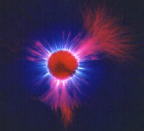|

In 1939 a Russian handyman invented a way of photographing the coloured light which supposedly surrounds
all objects, which mystics call the "aura". The pictures he produced amazed people all over the world, and here began the
science of Kirlian photography.
Kirlian photography is a means of representing the energy levels of the body in visual form. The process
is named after Semyon Kirlianand and his wife Valentina, who lived in a small town in the Ukraine.
Kirlianand was responsible for the maintenance of the diathermy machine in the local hospital ( this is
used to relieve arthritic pain ) in the winter of 1939.
As he completed the work and self tested the machine he saw what appeared to be a spark pass between the
skin on the underside of his hand and the diathermy pad.
Intrigued, Kirlianand decided to find out if the light from the spark would be strong enough to produce
a photograph. With the assistance of his wife, Kirlianand filled photographic trays with processing chemicals and placed a
sheet of bromide paper between his hand and the plate.
When the sheet of photographic paper was developed Kirlianand was able to see a faint impression of his
hand.To their amazement, they could see a glow surrounding his fingers.
There have been many cases reported of people who have displayed auras without using Kirlian photography.
Records of "glowing" humans are found in medical literature as well as religious writings and folklore.
In their encyclopedic collection of "Anomalies and Curiosities of Medicine", which was published in the
19th century, Dr George Gould and Dr Walter Pyle described a case of breast cancer that produced a light from the sore that
was sufficiently strong to illuminate the hands of a watch which was lying several feet away. Hereward Carrinton, an American
psychical researcher, also told of a child whose body, after death from acute indigestion, was surrounded by a strange blue
glow.
The case of the glowing human
The following case comes from a letter to the "English Mechanic" dated September 24 1869:
An American lady, on going to bed, found that a light was visible on the upper side of her fourth toe on
her right foot. Rubbing increased the phosphorescent glow and it spread up her foot. Fumes were also given off, making the
room disagreeable ; and both light and fumes continued when the foot was held in a basin of water. Even washing with soap
could not dim the toe. It lasted for three-quarters of an hour before fading away, and was witnessed by her husband.
Sole Light
Many mystics and occultists maintain that each human being is surrounded by light - or an
aura - of varying colours, which can be seen after occult training or by natural clairvoyance. The strength of this light
is supposed to be brightest around those who are in a state of ecstacy.
Nandor Fodor (1895-1964), the Hungarian writer on para-psychology, believed that medieval saints and mystics
distinguished four different types of aura : the nimbus, the halo, the aureole and the glory. The nimbus and halo stream from
or surround the head, and the aureole emanates from the whole body. The glory, meanwhile, is an intensified form of the whole
body glow - a flooding light.
Various colours of aural light are also said to indicate differing emotional states or character. Brilliant red means anger and force ; dirty red, passion and sensuality ;
brown, avarice ; rose, affection ; yellow,
intellectual activity ; purple, spirituality ; blue, religious devotion
; green, deceit or in a deeper shade sympathy.
|

